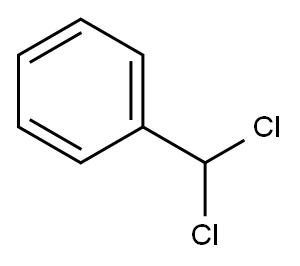벤잘클로라이드
|
|
벤잘클로라이드 속성
- 녹는점
- -16 °C
- 끓는 점
- 207 °C
- 밀도
- 1.254
- 증기압
- 60Pa at 25℃
- 굴절률
- 1.5500
- 인화점
- 92°C
- 수용성
- 물에 불용성
- 용해도
- 클로로포름, 메탄올(약간)에 용해됨
- 물리적 상태
- 투명한 액체
- 색상
- 굴절률이 매우 높은 액체
- Merck
- 14,1057
- BRN
- 1099407
- Dielectric constant
- 6.9(20℃)
- 안정성
- 안정적이지만 습기에 민감합니다. 타기 쉬운. 강염기, 강산화제, 대부분의 금속과 호환되지 않습니다. 산성 또는 염기성 조건에서 쉽게 가수분해됩니다.
- LogP
- 2.97
- CAS 데이터베이스
- 98-87-3(CAS DataBase Reference)
- IARC
- 2A (Vol. 29, Sup 7, 71) 1999
안전
- 위험 및 안전 성명
- 위험 및 사전주의 사항 (GHS)
| 위험품 표기 | T | ||
|---|---|---|---|
| 위험 카페고리 넘버 | 22-23-37/38-40-41 | ||
| 안전지침서 | 23-26-36/37/39-45-38-36/37 | ||
| 유엔번호(UN No.) | 1886 | ||
| RTECS 번호 | CZ5075000 | ||
| 위험 등급 | 6.1 | ||
| 포장분류 | II | ||
| HS 번호 | 29036990 | ||
| 유해 물질 데이터 | 98-87-3(Hazardous Substances Data) | ||
| 독성 | LD50 orl-rat: 3249 mg/kg NTIS** PB214-270 | ||
| 중점관리물질 필터링 | 별표2-30 |
벤잘클로라이드 C화학적 특성, 용도, 생산
개요
Benzal chloride (dichloromethylbenzene, a,adichlorotoluene, benzylidene chloride) is produced exclusively by the side-chain chlorination of toluene. It was first synthesized in 1848 by A. CAHOURS, by using the reaction of PCl5 with benzaldehyde. Almost the sole application of benzal chloride is in the production of benzaldehyde.화학적 성질
Benzal chloride is a combustible, fuming, colorless, oily liquid; fumes on exposure to air. Faint, pungent odor.용도
α,α-Dichlorotoluene has been useds as initiator during the atom transfer radical polymerization (ATRP) of styrene and methyl methacrylate.일반 설명
A colorless oily liquid with a faint aromatic odor. Insoluble in water and denser than water. Strongly irritates skin and eyes. Used to manufacture dyes.공기와 물의 반응
Insoluble in water.반응 프로필
BENZAL CHLORIDE is incompatible with strong oxidizers and strong bases. BENZAL CHLORIDE readily hydrolyzes under acid or alkaline conditions. BENZAL CHLORIDE reacts with metals (except nickel and lead). .위험도
Strong irritant and lachrymator. Probable carcinogen.건강위험
Acute: vapors are highly irritating to eyes. May be fatal if inhaled, swallowed, or absorbed through skin.화재위험
Fire may produce irritating or poisonous gases. Runoff from fire control water may give off poisonous gases and may cause pollution. Cylinder may explode in the heat of fire. Reacts with water to release hydrochloric acid.Safety Profile
Confirmed carcinogen with experimental carcinogenic and neoplastigenic data. Poison by inhalation. Moderately toxic by ingestion. A strong irritant and lachrymator. Causes central nervous system depression. Mutation data reported. When heated to decomposition it emits toxic fumes of Cl-. See also CHLORINATED HYDROCARBONS, AROMATIC.잠재적 노출
Benzal chloride is used almost exclusively for the manufacture of benzaldehyde. It can also be used to prepare cinnamic acid and benzoyl chloride.운송 방법
UN1886 Benzylidene chloride, Hazard class 6.1; Label 6.1—Poisonous materials.비 호환성
May form explosive mixture with air. Reacts with water, air, or heat, forming fumes of hydrochloric acid. Reacts (possibly violently) with acids, bases, strong oxidizers; many metals; potassium, sodium, aluminum. Attacks plastics and coatings.폐기물 처리
Incineration @ 816 C, 0.5 second minimum for primary combustion; 1204 C, 1.0 second for secondary combustion; elemental chlorine formation may be alleviated through injection of steam or methane into the combustion process.벤잘클로라이드 준비 용품 및 원자재
원자재
(1,1,2,2-tetrachloro-2-phenylethyl)benzene
trans-alpha,beta-dichlorostilbene
11-Chloro-1-undecyne
(1,2-dichloroethyl)benzene
D-다이하이드로제라니올
10-UNDECYN-1-OL
4-(2-HYDROXYETHYL)BENZONITRILE
2-BENZYLOXYTETRAHYDROPYRAN
클로로(2-)에틸벤젠
페닐프로필 알코올
준비 용품
벤잘클로라이드 관련 검색:
벤조트리클로라이드 p-클로로벤조트리클로라이드 벤잘클로라이드 플루오르벤잘4-)클로라이드 디클로로메탄 1,4-비스(트라이클로로메틸)벤젠
Diphenyldichloromethane
3-FLUOROBENZOTRICHLORIDE
ALPHA,ALPHA,ALPHA,ALPHA',ALPHA',ALPHA'-HEXACHLORO-M-XYLENE
2-CHLORO-6-FLUOROBENZOTRICHLORIDE
2-FLUOROBENZAL CHLORIDE
alpha,alpha,alpha',alpha'-Tetrachloro-p-xylene
3-(DICHLOROMETHYL)BENZOYL CHLORIDE
4-FLUOROBENZOTRICHLORIDE
9,9-DICHLOROFLUORENE
2-Chlorobenzotrichloride
ALPHA,ALPHA,2-TRICHLORO-6-FLUOROTOLUENE
3,4-Dichlorobenzotrichloride









